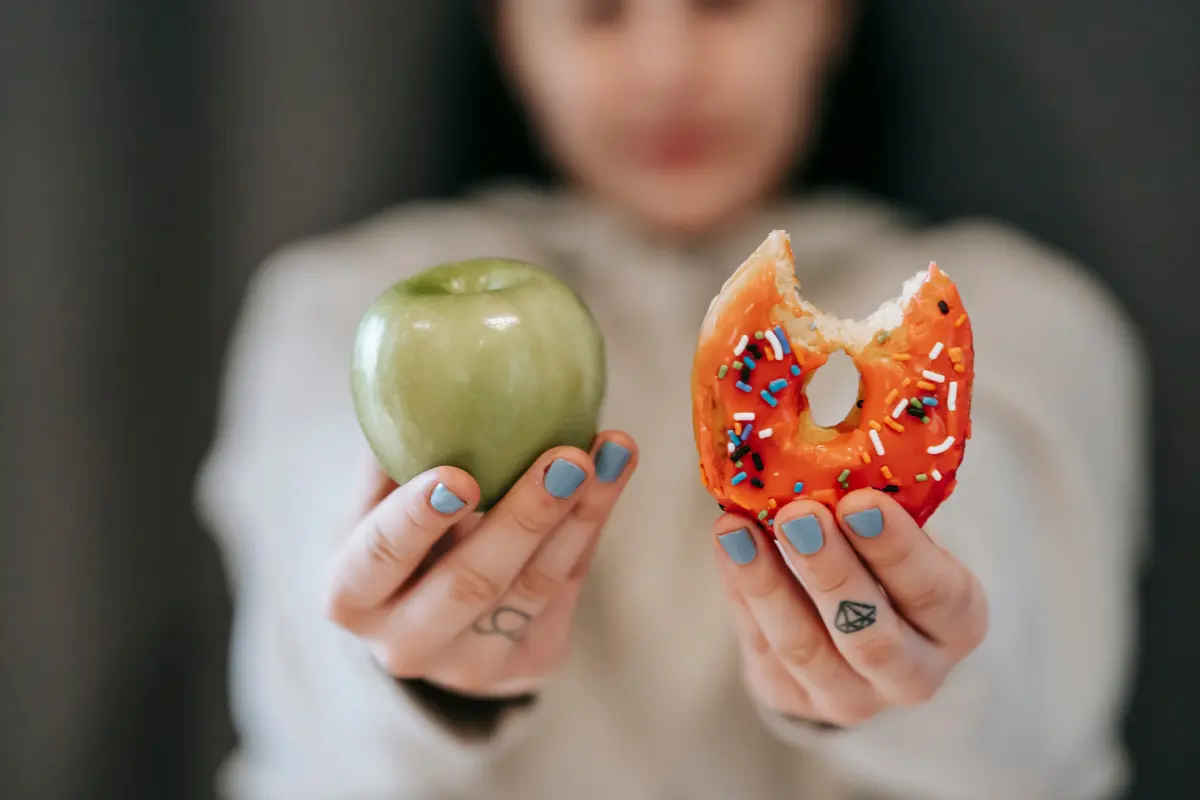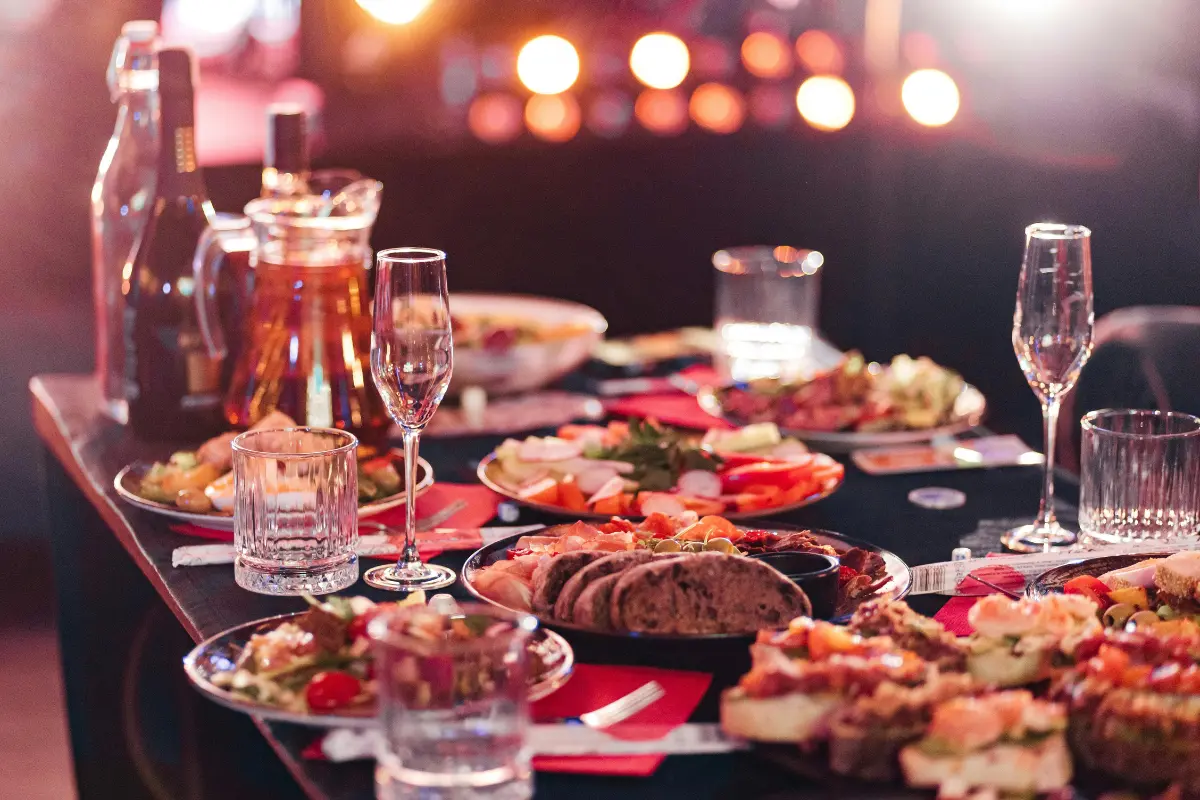
As a dietitian, I’ve seen one pattern hold more people back than any specific food choice, calorie target, or macro breakdown: the all-or-nothing mentality. You know the one—where every meal feels like a test you either pass or fail, where a single unplanned snack can convince you the entire day is ruined, or where you feel like you’re constantly bouncing between being “on track” and “starting over.” This mindset shows up in countless ways: rigid food rules, guilt after eating something you enjoy, the belief that there’s only one “right” way to eat, or the pressure to follow a plan perfectly or not at all. And while this mentality often comes from a place of dedication and high standards, it quietly becomes the very thing sabotaging your consistency, confidence, and long-term progress.
In this blog post, I want to help you step out of that black-and-white way of thinking and into what I call the gray area—a more realistic, flexible, and sustainable approach to nutrition that supports both your physical goals and your mental well-being. Let’s redefine what success looks like and create space for imperfection, growth, and a way of eating that actually fits your real life.
Your Perfect Week Might be Sabotaging Your Goals
You got through the week so well. Monday through Friday was spot on. You took time to meal prep. You hit every macro, optimized meal timing, and saw some great progress on the scale and with your measurements. Then Saturday rolled around where a friend called you up for dinner. You ended up eating a meal that wasn’t exactly “part of the plan” and now you are left feeling that you messed up. That voice in your head screams at you “You messed up. Your day is ruined. The week is a wash. Why even bother now. So, you might as well just go overboard and restart on Monday.”
Sound familiar? If it does, you aren’t alone. This mindset is so very common for athletes, goal-setters, and anyone that desires to optimize their life and health. Many times that mindset is what helped you get started in the first place. That drive, that dedication, and that perfectionist mentality can help in some scenarios, but it can also be the main factor that sabotages forward progress.
That drive to be perfect, especially when it comes to food and your diet, is actually the number one obstacle when it comes to consistency. This mentality is what is considered the ‘All-or-Nothing’ (AON) food mentality, which is where you either think a meal or food is “perfect” and compliant or “bad” and a complete failure. Always thinking in black or white will forever be the biggest obstacle to achieving sustainable, long term results not just for physical body composition, but overall mental well-being too. AON mentality will eventually lead to feelings of guilt and shame which is what drives binging tendencies and the constant flip flopping between ‘being good’ and crash and burn every single weekend.
The purpose of this article is to help reframe that AON mentality by introducing the best area to live and eat in- the Gray area. A space that is between ‘perfect’ and ‘failure’. The area that is not good, but not bad either. This space is the missing puzzle piece in your journey to create sustainable 'diet' consistency, lasting mental health, and putting an end to the frustrating weekends of “might as well start all over again Monday morning.”
Stop Calling Food “Good” or “Bad”
Food is Not a Moral Issue
Food has many labels with the most common labels being “good” or “bad”. We think foods like chicken and veggies are ‘good’ whereas foods like cake and alcohol are ‘bad”. This misuse of word labeling is what creates unrealistic expectations of our dies, actions, and self worth.
As an RD, I want to make one thing clear. Food is morally neutral. It isn’t good or bad. Food is simply a vehicle that provides the body with a combination of nutrients (think protein, vitamins, minerals) and energy (think calories). Food is never naughty or righteous.
Instead of thinking about food as either bad or good, I encourage you to view it either by its utility (how useful it is) or its frequency (how often you eat it). Let’s go through a few examples of foods:
Broccoli is a high utility/high frequency food
A piece of cake is a low utility/low frequency food
Poultry is a high utility/high frequency food
Potato chips is a low utility/low frequency food
None of those examples are good or bad. They all have a place in a sustainable, long-term diet.
Let’s think about other things in life. Like a barbell. If you use it with sloppy form and hurt your back, the barbell isn’t bad and you throw it away. Right? Instead, you adjust your technique and approach so that you can continue to lift. Food doesn’t need to be treated any differently! When a choice doesn’t serve you in the way you hoped, adjust your next choice.
The Hidden Costs of Nutritional Guilt
The AON mindset isn’t just hurting your mental health, it hinders your physical progress. The vicious cycle of shame and guilt after what you might deem a slip up or failure is what typically fuels a binge- the “I already failed; so, what is one more cookie?” The ongoing feeling of pressure, shame, and guilt around what and how you are eating can lead to elevated cortisol. Unfortunately, chronically elevated cortisol levels can make it harder for the body to do the functions we want it to do when it comes to fat loss. Instead of better blood sugar management, decreased fat storage, and improved recovery, the opposite happens resulting in poor blood sugar management, increased fat storage, and impaired recovery. How ironic is that? Your attempt to be “perfect” to cut fat by stressing over every detail actually results in the opposite of what you want and leads to physical and mental roadblocks that will leave you forever frustrated and discouraged.
Embracing the Gray Area: Your Gateway to Freedom
If you are struggling with the AON mentality, not all hope is lost. I am here to help you find the tools and new mindset that will help you move beyond the AON thinking to find sustainable consistency once and for all. Starting with a shift in mindset.
Mindset Shift #1: The "Next Choice" Rule
Let’s think back to school for a moment. Do you remember how you could miss 1-2 problems on a test or project and still receive an A as your final grade? Nutrition is the same. I encourage you to stop viewing your nutrition as one big pass or fail test, but instead a 100 question test where you can mess up a couple of times and still do well. Bringing this back to nutrition- When you make a choice that deviates from your plan, don’t spiral or panic. One slip isn’t going to be detectable if the rest of your choices are generally healthy and better. The moment that choice is over, you have a brand new moment to make a different decision. Let the script become “Ok, that choice is done. My next choice will be a choice that aligns with my goals. I will have lean protein and veggies for my next meal.” instead of “ I blew it. Now I will just eat whatever I want now.”
This mentality shift is what teaches you damage control and the art of pivoting, which prevents one choice from becoming a multi-day binge.
Mindset Shift #2: Failure is Just Data
The best part about the Gray area is that there are no failures, just data points to learn from. A meal that doesn’t go as planned isn’t a failure, but simply information that can provide insight to important factors such as hunger, environment, or social needs. There might be a reason why you ate more than you planned for, which can provide an opportunity for growth and improvement.
Here is the kicker… In order to gain valuable data points, the information must be logged and tracked! One of the biggest mistakes that people make is hiding from the evidence. I see this all the time- clients don’t track a meal because they don’t want to see what the choices actually cost (in terms of macros and calories). But that information teaches you to confront reality where you learn what choices mean so that you know how to learn, adapt, and move on. So facing the unknown results can finally result in learning a very critical skill- the act of embracing imperfection and moving on.
Mindset Shift #3: The Power of 80/20 (or Even 90/10) Rule
Let’s get something clear. A single day of perfect tracking doesn’t give you the results you ultimately want. Just like eating one low utility/low frequency food won’t cause you to never reach your goals. Your body and your results are measured over a period of weeks and months (actually YEARs), not a single 24-hour time period.
Being compliant to your goals at least 80-90% of the time will give you better results than if you were perfect 30% of the time. Trying to aim for perfection, but doing it inconsistently, will leave you spinning in your wheels. Aiming to be consistently good where you are allowing for a 10-20% buffer to live life, navigate unexpected events, and enjoying treats ultimately makes your plan enjoyable and sustainable which results in an effective long term ‘diet’.
Three Tools to Practice the Gray Area
Now that your mindset has shifted, it is time to learn how to implement those practices to effectively build flexibility and resilience into your long term “diet”.
Tool 1: Pre-Load Fun Foods.
Remember, food is morally neutral. Meaning that you aren’t breaking or cheating on your diet if you enjoy a treat or fun food. In order to stop the guilt that can trigger the AON train, let’s budget for the fun! When you know you are going to a party, dinner, or event, plan the food ahead of time. That food, meal, or drink is just another part of your macro/calorie budget. I have found the most success by logging the indulgence first to help build the rest of my day around that so that I can truly have my cake and eat it too. I will look up the calories/macros for a typical serving of what I want, log it, then proactively plan the rest of my day to fit in that planned treat where I might enjoy a smaller breakfast or swap out my go-to apple and PB snack for an apple and nonfat greek yogurt snack.
By budgeting, the experience changes from a failure to a moment of calculated enjoyment- an act of always being in control of your choices while learning how to successfully fit in different foods. Fun foods become just another macro to budget in instead of avoiding.
Tool 2: The "Minimum Recovery” Tool.
The natural reaction when an AON moment happens is to allow the pendulum to swing in the complete opposite direction: extreme restriction. But the result of restricting usually is another binge not too far down the road. The AON truly is a cycle!
Instead, the best way to move on from an AON moment is to simply recover instead of trying to undo. My advice is to always focus on doing the minimum effective dose for the next 12-24 hours. This usually is simply prioritizing protein and hydration because protein is the most satiating macro nutrient and it is absolutely vital that we consume it daily. Protein helps stabilize blood sugars and hunger, which stabilizes mood and metabolism, which prevents the spiral into another binge. We are simply moving on instead of engaging in punishment via fasting or extreme restriction.
Tool 3: Build a Solid Foundation with Habits
Here's my RD secret: the Gray area isn’t just about the grams you hit, but it is more so about the non-food habits you do daily that result in making the healthier choice easier and you more resilient. So what are these non-food habits? I am talking about sleep quality and quantity, hydration, movement, stress management, social connection, and self care. These kinds of foundational habits help mitigate any “miss” because these habits greatly influence your energy, stress, appetite control, and self-worth thus making it easy to rest and be consistent the next day (if not the same day!).
The next time you feel guilty about missing the mark on anything or enjoying a low utility/low frequency food, ask yourself “Did I hit my foundational habits for the day?”
Here's a few examples:
Did I drink my water target for the day?
Did I sleep at least 7 hours?
Did I engage in movement for at least 30 minutes?
Did I connect socially or practice a few moments of stress management?
The Real Measure of Success
The Gray Area is not permission to be reckless; it is simply the mental shift and skill that allows you to navigate real life while prioritizing your goals. It allows for flexibility and self-compassion, which in turn helps you become resilient and consistently successful over the long term.
Remember, food is morally neutral. You aren’t a bad person for eating a cookie, and you aren’t a failure for enjoying seconds when you planned for just one serving. You can achieve so much success when you allow yourself to plan for indulgences while focusing on being consistently good. Ultimately, your progress is the result of a marathon of consistency, not a sprint of unsustainable perfection.
Practice "Next Choice" Today
I encourage you to start practicing this mindset today by implementing the “Next Choice” mentality. There are 86,400 seconds in the day, which means there are 86,400 chances to make the next choice. Use one of them right now to step back onto your path.
Alex Oskian
Alex is a WAG Coach, Registered Dietitian, and Certified Strength and Conditioning Specialist with a Masters Degree in Exercise Science. Outside of working with her clients, you can find her at her local gym, getting active outside, playing with her dog and cat, enjoying a coffee, or hanging with her husband.
Schedule a Free Intro Call
Working Against Gravity has led the macro tracking and health space for over a decade. Our team doesn’t just understand the science of nutrition—we’ve spent years mastering the art of tailoring it to fit your life. That means no cookie-cutter plans, just real strategies that have worked for over 30,000 people.
Schedule a free call with our team to learn how working with a 1-on-1 WAG coach will help you reach your goals.


